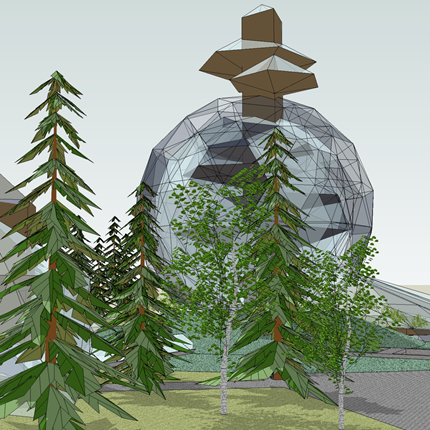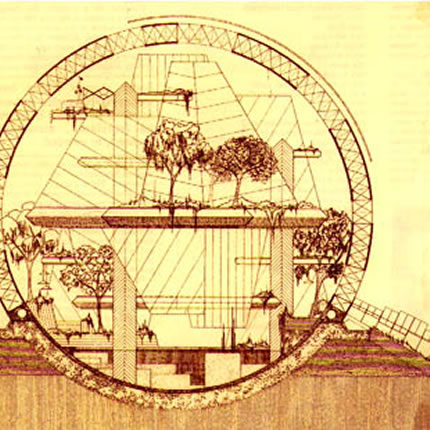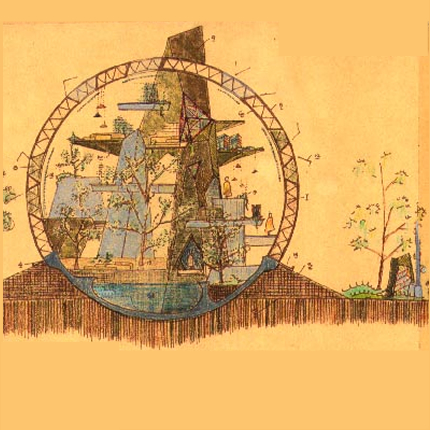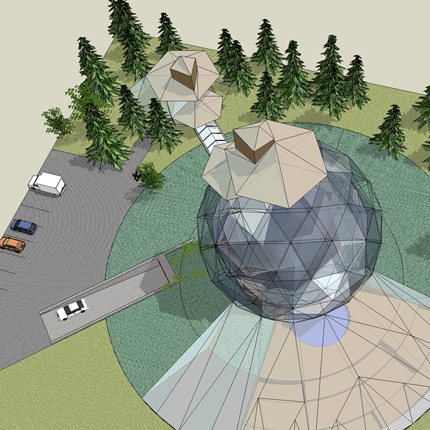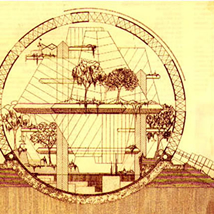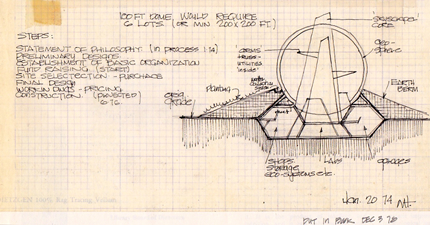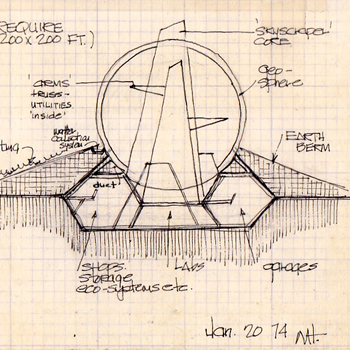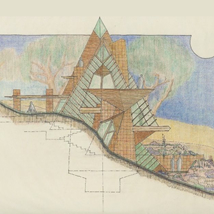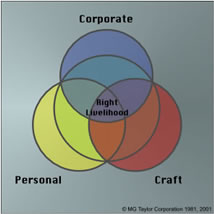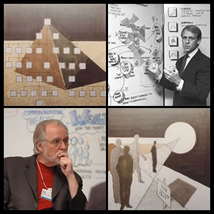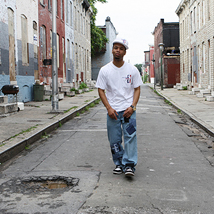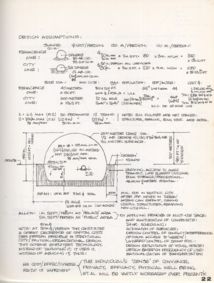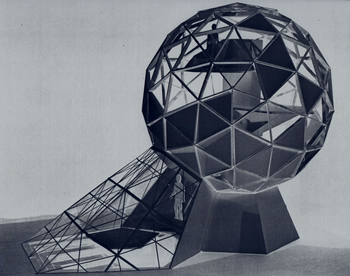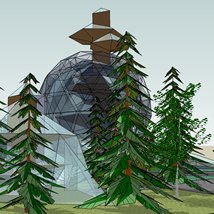Domicile One Design Development 2010 - 2013 |
click on drawings above for background on this project |
a step toward realization |
| The work done on Domicile One over the last 33 years, in terms of the Design Development Model, has been in the Program and Schematic steps. |
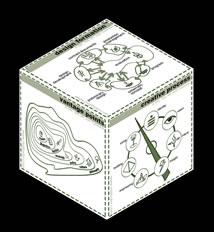 |
The SOLUTION BOX Architecture provides a 7x7x7 grid of steps an idea goes through from concept to use. It provides a map and language to track where a project is and to know the veracity of the work along the path. |
|
click on Model for more |
| To get to Design Development, a Program Statement for a specific project has to be developed as well as updated Schematic and Preliminary drawings produced. |
| The goal is to get Domicile One through Design Development by sometime early to mid 2011. This means that a level of engineering will be finished as well as estimated cost and construction times completed. As Domicile is a product of a design/build/use approach to architecture, this means a pro-forma of the cost-to-live-per capita, per-year is also a critical aspect of this iteration of work. The Design Development level of work will facilitate potential participants for a prototype community project to evaluate if moving forward on such a project is what they want to do. |
| So, the first section of this web posting will start with a Performance Criteria Statement which will co-evolve with a bank-and-forth process of Program, Schematic, Preliminary work iterations. When this work reaches a coherent and comprehensive statement, then the formal design Development work can begin. |
|
|
| Domicile is not an isolated project in terms of my body of work. It is a seminal project given the many ways it ties to critical aspects of the MG Taylor Mission and also to key elements of my personal approach to the design and building of architecture. The ideas which lead up to Domicile, and have emendated from it, have incubated in my mind literally for decades. They have become as near a statement of my personal design signature as is likely to happen for a number of years yet to come. |
| Preparing Domicile for construction will require development in collaborate processes and governance including extending the ValueWeb theory and practice into the realms of construction management, real estate and the ownership and use of commonwealth and individual property. Domicile itself will require technical improvements - and systems integration - with energy, plumbing, structural and materials engineering. The design and prefabrication methods now employed by AI for the creation of work environments, will have to be extended to meet the challenges of Domicile’s continuously adapting interior environment. This “action research” will immediately apply to ongoing AI and tsmARCHITECTURE client projects including the next generation RDS project. |
| Domicile’s non dome prefabricated structural elements are of the scale required for the Bay Area Studio, shedwork and affordable housing units and modules for postUsonian Project prototypes. |
| The food growing, preparation and recycling requirements of Domicile - and their application to an urban setting - directly relate to the Bay Area Studio and Steinmeyer House projects as well as the Bootstrap into Space concept. |
|
|
common and unique design elements of prior Domicile sketches: |
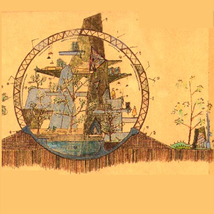 |
| The original version had a small Entry/Office connected to the Main building by an partially underground tube. This is not shown, due to the location of the cross section cut, yet intended in the 1977 version. In 1968, the Greenhouse was in the dome. A greatly expanded greenhouse structure is shown in the 1977 and 2010 designs. Due to smaller size and craft construction, the 1968 design can be self-built by an amateur group. |
|
| There are a number of design elements which can be found in all three versions of this design - the dome itself, as an active “environment valve” is the most predominate. Each version of the dome shows different ways for the dome system to interface with the outside world and weather including opening and closing panels, some solid, some glazed with an interior shield on the South side (1968), a rotating exterior shield (1977), to almost total glazing - due to modern glass techniques - with the 2010 version. Depending on regional placement and specific site locations, some combination of all of these techniques may be required and remain viable and may be used in a variety of different projects determined by the requirements of the habitants and the location of the building. The evolution of the design concept over the 44 years of it’s incubation is primarily in two areas: a shift towards more sophisticated building methods and a growing intention of building an environment capable of 100 percent self-sufficiency if this be required given possible future scenarios. If you think of a Domicile as a Jane Jacobs “replacement” community, with an internal and external economy, total self-reliance and the ability to trade with the larger economy is the ideal synthesis. |
|
|
| I still intended for the 1977 version to be build able by a community group although Bucky fuller disagreed with me on this point [link: renascence reports Viol 1, #10, p1]. The 1997 iteration eliminated the central core which pierced the dome at the top and instead shows four vertical supports for the platforms which also provide utility runs and air ducts. This allowed the earth tempered air to circulate into the enclosed private zones. |
|
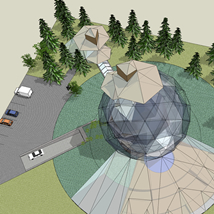 |
| The cantilevered skyPOD units on the external support core goes back to the Xanadu Project (1958, 2000) and was explored again with the Snowflake configuration of the Nashville MG Taylor Compound design in 2005. The skyPOD is employed for the office complex. This is a natural extension of the concept. The 2010 design also makes use of an extensive underground infrastructure, shown below, first sketched out in 1974. |
|
performance criteria for Domicile One: |
structure and building methods |
mechanical and organic systems |
capabilities and accommodations |
| The geodesic dome will be a double shell, fabricated in truss sections, and erected around the prefabricated interior platforms after they have been put in place. The double shell will act as a wick circulating 57 degree air from earth sink water storage wells. The dome skin is predominately glass with added opening solar cell flaps to provide shade and generate power. Flaps on the inner skin will activate for temperature augmentation. |
| provide a structural “living” skin controlled by algorithms to act as a constantly adjusting interface between the exterior environment of temperature, wind, light and the required internal environment |
| The double shell glazed greenhouse is a radial extension of the dome and a key component of the passive and active solar system. It houses three functions: food growing, food preparation, and sun room - swimming pool. The greenhouse is the outside inside providing this amenity in all weather conditions. As such, it is a natural extension of the Commons functions of the Domicile environment and social system. |
| provide the experience of food and physical recreation in a protected environment which still reflects the seasons while maintaining necessary food and energy production |
| The Entry and skyPOD Units provide important out-of-Domicile yet integrated functions. The Entry protects the community, when necessary, from the intrusion of “external” business and the skyPODs a place “away” for personal retreats without having to leave the compound. This adds amenity while allowing a greater openness and fewer “protected” spaces inside the main facility thereby promoting community. |
| provide three zones: an outside-inside entry-meeting function, Inside-inside personal and group living-working function, an inside-outside personal retreat function for individuals and couples |
| foundations and below ground walls |
| Foundations and below ground walls will be constructed of high quality structural concrete. In appropriate climates and for selected sections of the system high grade compacted earth can be used. The underground space houses parking, storage, mechanical systems, the greenhouse area and lowest platform of the commons living area. In this foundation disaster protection areas will be provided. |
| provide a foundation structure capable of holding the Domicile superstructure and provide the maximum security to inhabitants and resources possible in the case of explicitly studied scenarios. |
| walks, berms, ramps, patios, fencing |
| The design of the exterior landscape will provide permaculture eatable planting, outdoor recreational facilities while also acting as a secure yet inviting parameter to the facility. Berms will attenuate sight lines and wind impact while creating interesting areas of distinct character. The layout schema is to support inhabitant’s awareness of what is happening off-property while also creating an inviting space for the larger community. |
| provide a secure yet inviting permeable parameter which in balance protects the privacy of Domicile while inviting appropriate interaction and use from the larger urban community |
|
| Geothermal wells connected to the water storage system and the air supply system by heat exchangers, provide a base 57 degree boundary between the exterior and interior skins of the Domicile which is further mediated by solar paneled sun screens, all creating a natural temperature metabolism which then requires only marginal active, mechanical, solar power supplied, heating and cooling. |
| provide an integrated, passive-active earth-solar-mechanical system which supplies naturally tempered air to interior spaces and buffers between exterior and interior climes |
With recent developments of glass and solar cells, the distinction between “passive” and “active” solar is disappearing. Glass is becoming structural and capable of significant R values. A variety of new solar cells provide increased capacity, reduced costs and a variety of form-factors. Solar cells can now be embedded into glazing providing shade and power simultaneously. The age of glass has come.
| provide integrated passive - active solar energy system for inhabitants: heating and cooling, generate electricity, and full spectrum lighting, within the glazing system |
|
| water cycle, capture and retension |
| The water system engineered to be engineered as a complete life-cycle process taking water through several iterations of use before returning it - as clean or cleaner than when captured - to the environment in a way involving no uncontrolled runoff, etc. Both external (retention ponds) and internal (at dome, berm intersection), water capture will be employed. Greenhouse and external planting are integral to the system. |
| provide an integrated water system which manages the resource from capture, retention, to use and recycling, returning only such water to the environment, in a clean state and which is best for it |
| Supplementary mechanical systems are necessary and critical to the Domicile heating, cooling and fresh air processes for augmenting passive systems. The skin of the building will actuate so that the structure will breathe as much as possible per both human selection and computer control. Solar-electric Geothermal heat pumps activate after the earth-air circulation and passive solar systems have provided the base temperature. |
| provide a “metabolic” geothermal solar passive active heating and cooling system which receives all of its energy from the site and imposes no thermal impact which cannot be absorbed by the site |
The Domicile food cycle will be treated as a “closed” system in the sense that - including imported and exported food - the on site cycle will be managed as a system with no resulting exported waste product. A basic diet for 75 inhabitants will be grown, consumed and recycled on site employing greenhouse and Permaculture methods. “Luxury” food products will be traded for or bought while maintaining an energy balance.
| provide an integrated “slow” food organic growing and consumption system with Domicile technology and inhabitant labor as an internal economy and ritual |
|
|
Five permanent families is the design goal of Domicile One. The question is what is the appropriate design number per family? An extended family is the more stable one. Also, there has to be facility for family guests and guests of the domicile as a community. There will be need from time to time for care-givers and teachers. In certain scenarios there will be the need for the Domicile to function as a hospice.
| provide for 5 families @ 10 members each plus a temporary 6th family unit of 10 plus 5 guest units of 3 persons for a total of 75 inhabitants |
|
| Housing with most commercial buildings, focus on the horizontal square footage contained by the default flat-earth “view” of low ceilings. Few architects are noted for their ability to create space and remarkably few built examples exist which exemplify four dimensional living: horizontal and vertical space with time passage as an active factor. Domesticated humanity is thereby cut off from a whole experience of reality. |
| provide for multiple kinds of group and individual spaces creating a volume-focused landscape of prospect and refuge, free and purposed spaces, the nuances of passing time and seasons |
| commonwealth assets and tools |
| Tooling is a major requirement of modern living. Personal tools are best owned and maintained by individuals. Complex tools by groups so that capital and maintained costs can be shared with use provided on demand. This idea is generally frowned upon by our society which is interesting when you consider that the corporation does precisely that and, when run well, greatly amplifies the financial productively of every worker. |
| provide for a common-wealth and personal-wealth system and culture to provide maximum amenity and tooling of the highest quality at minimum financial cost and maintenance overhead |
| Transportation is an integral element of the Domicile environment - not an add-on adjunct. This includes location, access to public transportation, the variety of modalities from walking, bicycles, short range electric vehicles supplied by Domicile solar to long range hybrid or alternative fueled cars. Shared ownership and on-demand scheduling can radically cut the number and use of high impact vehicles. |
| provide a transportation system which balances cost, sustainability, health and time-use issues yielding the best utilization for a Domicile’s community as it configured in it’s specific urban context |
| computing and virtual technologies |
The Domicile must be a smart building able to autonomously respond, in a biomimicry/ organic way, to a variety of internal and external conditions while maintaining dynamic stability with: weather changes, internal temperature loads appropriate for specific activities, “breathing” with external air, lighting related to type of activities at various locations and seasonal changes, parameter security and movement of people.
| provide a nervous system capable of autonomous, cybernetic regulation of all mechanical-biological systems to achieve dynamic homeostasis |
|
|
|
governance |
ecomomy |
life-work patterns and options |
| Whatever the organizational structure, it is the charter which creates the dna of the enterprise. In recent decades, this vital first step of formation has been neglected. There are generic aspects to any Domicile Charter and there will be specific to a time, place, and user group clauses. The Charter establishes the Mission of the enterprise, states the general rules of engagement and the boundaries of it’s operation. |
| provide a Charter framework which establishes the legitimacy of a Domicile effort and defines the critical must-have elements of it’s by-laws, operation, ownership, and entry, exit processes |
| organizational structure(s) |
| The Domicile concept can work with a variety of ownership and enterprise business models. Exploration of many types is encouraged. Within the meta-structure of the Charter, each ownership architecture will be determined by a specific group of investor/users. This ownership architecture, along with a system of basic inhabitant rights and obligations, will then determine the specific organizational structure employed. |
| provide a basic rights and obligations statement for each role: ownership, management, inhabitant, guest, as a foundation for a wide variety of ownership and organization structure/processes |
| A wide variety of ownership structures are possible for a properly functioning Domicile from a “hotel” model, a “constitutional republic, an equal shares democracy, to a commune. I think the make up of the inhabitant group will determine this. What is essential is the issue of franchise and the equality and interaction of members in terms of governance (within Charter limits) and the day-to-day decision making process. |
| provide a broad ownership framework open to many variations and a tight set of “must have” governance protocols for the determination of Domicile operations |
| Miller’s Living Systems Model describes the many components which make up any dynamic system. Among these are boundary and interface functions. To remain viable a system must preserve it’s integrity and successfully interface with other systems. As a 21st Century enterprise, Domicile has to reinvent a number of default rituals and rules which govern the behavior of the permeable membrane between Domicile and society. |
| provide an equitable and non prejudicial interface function which protects the Domicile Commons while providing the tools for each member to craft their personal social prospect and refuge factor |
| joining and leaving a Domicile |
| Joining or leaving any family, affinity group or organization is never easy. It is almost always stressful and often because of, or the cause of, anger and dispute. It is in these times that the interests of a member can come into conflict with another member or members can cause great disruption to the enterprise commons. Entry/exit protocols are critical and must be designed with care and managed with objective discipline. |
| provide a clear charter, mission and contract along with the means for members to alter it over time yet only within the intent and scope of the original mission - craft simple, robust rules of joining and leaving |
|
The economic goal of Domicile is to eliminate wage slavery and provide an alternative to the mindless consumer life-style by radically cutting the capital costs of building a human habitat and community. To reduce each individual’s cost-of-living to a fraction now required to support a middle class existence. Thereby making the choice between working to earn more money or engaging in more leisure a true one.
| provide an economic do-no-harm engine which doubles the middle class living standard at half the capital cost and one quarter annual expenses per capita |
|
| engagement with external economies |
| Stafford Beer’s Viable Systems Model states that every subsystem necessary to an effective organization has to be replicated at every recursion level of the system. Economic viability requires a whole ecology/economy on individual, family, group, community, city, region, state and planet scales. Lacking this, the system becomes brittle and subject to catastrophic collapse. |
| provide a whole ecology/economy at the Domicile scale that can, as an equal, metabolize with local, regional and global ecologies/economies for mutual profit and sustainability. |
| creating a 21st century economy |
| By now it is not rocket science to know that Humanity and planet are in the midst of an economic revolution and that continuing to amplify old assumptions and processes with modern tools in a connected, leveraged, global system will systemically net out one bubble burst after another. It is critical to deliberately start building new economy prototypes from the ground up both to learn and to create pockets of stability. |
| provide a systematic applied R&D process to explore the nature of and build an example of a knowledge-based design economy on the scale of extended families and free-agent enterprises |
| the economy of shared resources |
| Domiciles can resolve the confusion between ownership and use of tools/resources while radically decreasing the incredible economic burden which this confusion imposes on individuals, families and small businesses of modest means. No matter short term economic ability the long term economic/ecological burden of unnecessary over production must be redressed. A habit based on necessary use can be practiced. |
| provide a viable on-demand, learning, scheduling system based on user profiles connected to supply and capital investment tooling system which nets the best service for minimum cost |
| transferring domicile equity |
| Domiciles are not a commodity. They are a landscape to live and work in and to work in order to secure an abundant way-of-life. If the external economy-of-leverage is allowed to intervene, Domicile’s external economic “value” will promote cashing out and speculation causing a barrier-to-entry for a new generation of members. This will hijack the wealth created for a one-time gain and defeat the purpose of the enterprise. |
| provide an ownership covenant that facilitates the buying and selling of Domicile shares based on the internal economy and a measure of true profit avoiding external market exploitation |
|
| individual and group interactions |
| In today’s social organizations, the individual and the group are often pitted against one another with compromise promoted as the best solution with dominance/submission offered as the alternative. This is simply bad philosophy and design based on false premises. Traditionally evolved and tested stable social processes have been fractured by modern means which are neither designed nor truly emergent in their structure/process. |
| develop, by a dynamic, feedback driven, collaborative design process a set of social rules-of-engagement which promote, equally, individual integrity and an emergent group culture |
| transformation of modern “lifestyle” |
| The focus of the Domicile life-style is on living - not consuming as an economic animal. The goal is to develop and exercise the personal creativity and the group genius of the Domicile meta-family at low capital and maintenance costs so that the community and it’s members have the time to pursue a life of purposeful learning and productive leisure with zero negative impact on Gaia and other planetary life forms. |
| provide a built artifact, to function as a systemic habitat-economy-ecology sustaining a knowledge-based-hunter-gatherer-life group process which creatively interfaces with the greater urban context |
The Domicile, to function, requires work on the part of it’s inhabitants as does any homestead. This is tithing, an ongoing in-vest-ment. It is production and ritual. It creates community and sustains the community. The effectiveness of the system is such that it provides a healthy and luxurious life-style and nets out abundant leisure for all members to invest in their true interests and life purpose.
| provide a physical system requirement and social-cultural-ritual, and set of protocols, which binds the community by the act of fulfilling community needs |
|
| With the growth of the knowledge-based, design-as-value-add, free-agent economy, work is returning to the home for millions of people. What is called “home” in today’s world is not designed to gracefully incorporate the work function causing disruption to both home and work-life. Integrating living and work functions should be and can be a liberating process allowing recreation and work to flow freely. |
| provide a layout of space, utilities and tools which integrates - and places the appropriate boundaries around - individual/group living/work activities preserving the integrity of each function |
| domicile(s) and social transformation |
| The core of the Taylor Method approach to individual and social transformation is to build, through multiple iterations, the most viable future environment possible and invite people to use it as they plan for their future. A variant of this approach is to live and work in a “future” solution while designing future solutions. Domicile provide a means to live better while evolving better solutions by linking experience with designing/doing. |
| provide, by facilitation, an inhabitant generated mission for each Domicile which provides a context “greater than” and incorporating the interests, goals and life-quests of each inhabitant |
|
|
|
|
GoTo: New Business paradigm |
|
|
GoTo: Transformation Process |
|
|
domicile as architecture | gaia and master planning process |
bootstrap program and worthy problems |
| The Theme of Domicile is stated in its very shape: a large self-sufficient, eco-sphere with elements breaking out into air and landscape surrounded by eatable greenery. A lovingly stewarded Earth emerging into new dimensions of abundance populated by self-aware sentient beings responsible for their own lives. A pattern language repeatable on many scales - the blending of science, craft, intention, planning and emergence. |
| provide this context so that specific applications of the Domicile Concept can be recreated by real communities in a variety of social-ecological climates holding true to the idea with infinite variation |
| The way we habitat today has less than a 100 year history and on a global scale is still in the minority. This “western” way is associated with a higher standard of living yet this can be attributed to the technology far more than to the attached social systems and paradigm of wealth. Most affordable and co-housing programs, adapt the existing house and lack environments which have been designed for these old-new patterns. |
| provide a tight integration between the design of the structure/space, the program of use, and the social-economic model of the member inhabitants of a domicile so that the system produces the desired result |
| architecture as an active voice |
| Architecture is not a generic box in which to stuff life, work and utilities with some ad-on esthetics to soften the blow. Architecture shelters, arranges space and utilities, and expresses the purpose of the life, work and values of those who inhabit it. Architecture is an experiential art and acts as the brand of it’s user’s time and place. It selects and supports a specific way-of-life, builds intent to practice it and points the way to it. |
| provide an environment which expresses in every detail the quest, mission and intent of those who inhabit it thereby transforming every day-to-day activity to the level of living art |
| setting domicile into the urban context |
| A buildings can have radically different form-factors and materials and still fit within an existing urban setting. Fitness factors are more subtle than gross mimicry. Texture, mass, scale, interface at property lines, landscaping and historical references are part of the integration tool-kit. Domiciles will fit best in older neighborhoods and/or by employing sites which are challenging for conventional solutions. |
| provide a site-setting rule book to govern the Domicile placement in-filling process to enhance existing amenities, avoid over building, scale conflicts and deterioration of the existing social commons. |
| what follows from domicile |
| As a first step in a series of magnitude jumps and given it’s direct relationship to xanadu and Crystal cave, a large part of what follows from the making of the Domicile One prototype is readily apparent. And, assuming success, a great number of Domicile projects are certainly in order. All important outcomes. What may be of greatest significance is what is not predictable from this side of the experiment. |
| provide a feedback mechanism from the Domicile experience to the concept team so that weak signals can be picked up and employed in the recreation process of the concept and its derivatives |
|
| zero impact design strategy |
| Theodore Taylor is quoted in the Curve of Binding Energy that the only way to insure that human systems do not disrupt natural systems in unpredictable ways is to isolate any human built system from nature unless the element returned to the natural ecology is as clean or cleaner than when it was brought into the human system. This strategy has been successfully employed on numerous occasions yet never on the full scale of human/nature interface. |
| provide boundary and I/O system which permits beneficial exchange of values between Domicile and it’s exterior environment yet isolates each from the other in regards physical or social pollution |
| By the nature of the problem(s) it is designed to solve, and the design strategies the concept employs, Domicile is a transformational environment and living/working experience. The history of transformational efforts has demonstrated that an environment like this will fail if placed in isolation of other like-kind enterprises. Each Domicile project must be linked to other Domiciles and a variety of experiments and practices of a similar intent. |
| provide, throughout the process of design/build/use, links to a network of sympathetic efforts which - as a system - represent the full life-cycle of making-using intentional habits thus providing anticipatory support |
| crystal cave and xanadu relationship |
| Since their origins, Xanadu, Domicile, Crystal Cave - 1958, 1967, 2001, respectively - have been designs and programs which informed one another continuously. Design elements and pattern language solutions have flowed back and forth and will continue to so as each is made real some-time, some-where in whatever final form manifested. Xanadu is the mother ship of the nascent Taylor network, Crystal Cave the R&D Lab, Domicile the first step. |
| design and engineer these three projects in real time dialog so that each influences the other by bringing the past forward and the future to the present in order to create timeless works |
| The Taylor System and Method operates on 7 levels from neural nets to a super ordinate global system. Each of these levels are recursive, fractal, and self-replicating. The social system of a Domicile is made up of three levels and interacts with three levels outside of it. The integrity of these recursive levels has to be maintained and each has to be engaged, by a rule-based process, in the way intrinsic to it’s nature and role. |
| provide a map of the networks, degrees of connectivity, and small worlds which represent the social environment of Domicile’s community in order to keep this emergent reality in mind |
| prototype of self contained habitats |
| Domiciles One was conceived to be a first step in a series of environments, each one doubling the size and cubing the volume of the one before therefore reaching, in seven to eight project/recursion levels, the critical mass of a viable social system/“replacement city.” This is action research on how to grow successful Earth cites and space habitats. Each iteration presents new design challenges to be solved and documented. |
| provide capability, process protocols, inhabitant participation necessary to document, for a credible social science study, the actual living/working results of the Domicile system |
|
In the Taylor body-of-work, Domicile is a specific solution to a wide spread set of conditions found, in variation, in all societies on Earth. This is the work-to-live by performing non-value-added (to the worker) work trap. In addition, humanity - because of both need and quest - is exploring space as an habitat option without a practical means to test the social, economic, ecological consequences of real-time intentional building of complex human systems.
| provide, without compromise to either mission, a viable solution at the scale of Domicile while launching a series of projects which can scale by orders-of-magnitude |
|
| addressing the poverty trap |
The vast majority of humans are intelligent, diligent and well meaning yet poverty and violence are rampant around the world including within the so called “advanced” nations. The cause is systemic. Poor people lack education and the skills necessary to appropriately employ the city as a creative tool. The 6th family unit is the opportunity to adapt a family and gain the gift of diversity and end in a generation a recurring cycle.
| provide a program which adds social diversity while breaking the poverty cycle by granting a capital free full equity membership to a family of lesser material means |
|
| ecology economy synthesis |
| The “soul/body” dichotomy of the Western Tradition feeds the bifurcation of idea/practical, human economy/Earth ecology, art/science, vision/utility. This is perhaps the most destructive meme in the Human pattern language vocabulary. Start with a dichotomy and you will end with a contradiction. It is critical to demonstrate, by building/using alternatives that the soul/body distinction is bogus. |
| provide the practical means to an “ideal” habitat for a community of inhabitants, their associates, friends, extended family and larger community which demonstrates ecology/economy oneness |
| Architecture is accomplished by building a number of discrete works. A practice is the sum of buildings over a lifetime of work produced by an individual or firm. The sum of thousands of practices stand on the shoulders of, and add to, a documented history which goes back over 10,000 years on Planet Earth. Signature works incorporate broad architectural meaning into a project as well as meet local/individual requirements. |
| design, engineer, build and operate Domicile One to meet the requirements of it’s inhabitants while also achieving the broadest solution generality possible for multiple future application(s) |
| Domiciles, built as they are intended, will not serve as a Life Boat environment in the case of a major catastrophic event: massive solar flares, polar shift, large object hit from space, human use of weapons of mass destruction, etc. Properly placed, managed and protected, Domiciles can serve as refuge environments in response to lessor calamities: depressions, short social disruptions, hurricanes, floods, global weather change, etc. |
| design, engineer and place each Domicile to function in a selected, by it’s inhabitant community, risk range of human and nature caused permutations, and equip and train the community accordingly |
|
|
|
|
GoTo: One Community at a... |
|
GoTo: inner city development |
|
GoTo: Bootstrap into Space |
|
|
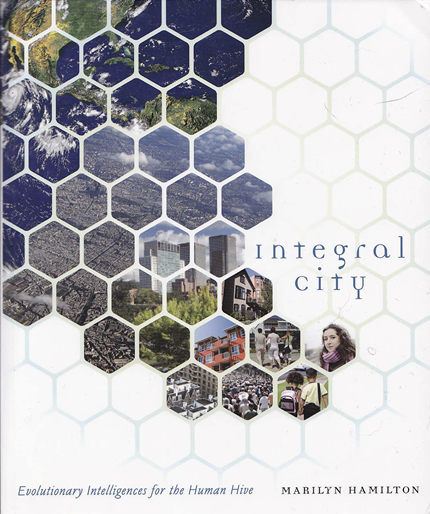 |
Integral City by Marilyn Hamilton builds a meta-framework for the city as a whole system.
I assert, and I think the approach outlined in the book strongly supports, that the same framework can be used on the many levels of recursion from the scale of one Domicile to that of Earth as a human-Giaian garden.
It is no longer tenable to approach the production of human habitats as a series of unrelated projects loosely bound by static, non-systemic zoning laws and building codes which vary from country to country, city to city. It no longer works to leave other species out of the equation with the exception of a now and then applied protection of this “endangered” one or another when the fact is now we all are endangered.
We have to move beyond parts thinking, regulations and narrow professional stove-pipes and create an integrated systemic view of habitat on Earth for all living beings including Gaia herself. And, we have to prototype a series of solutions, within this framework, which proves out this process and also tests the specific solutions themselves. |
|
|
design development studies and narratives: |
| Domicile is a concept and a system. It is also a set of prefabricated components which can be assembled in a variety of ways. Each Domicile will have the advantage of tested components and the economy of scale of production yet each will be modified and combined is a different way according to the requirements of it’s own community of Inhabitants. |
| The purpose of the Design Development phase is to design and engineer this kit-of-parts and to work thorough the protocols of how they fit together. |
| This kit-of-parts also has to include the necessary covenants and rules-of-engagement so that a variety of community and individual organizations, work and life-styles can function with harmony within the larger urban social landscape which cannot be assumed to be in a healthy homeostatic state. |
| I grew up in the Wrightian ideal of buildings which opened to and embraced nature. My work of the late 50s through the early 70s reflected this thrust. Domicile was the first, with EcoSphere quickly following it, work where I place a permeable yet consciously designed membrane between a habitat, the urban environment and the greater ecology. |
| This surprised me. The design came to me, in the 60s, a few years before, the 70s when I started looking at two things: first, what the human-building impact on Earth was; and second, the idea of recursive, fractal shells each with distinct integrity yet repeating patterns, and what were their strategies of how they engaged one another. This natural “design-strategy” can be found over and over in nature-build and effective human-built systems. The design issue here is one of interface not the making of defensive barriers. The boundary of a Domicile site or it’s dome is no different - and exists for the same reason - as the boundary we design and hold around a DesignShop® exercise for the duration of the event. The same recursive designs can be found in the Medieval city as detailed by Mumford [link: The City In History]. The opportunities for a skillful mix of prospect and refuge on successive scales are very high. |
| What passes through these shells - and what does not - and by what protocols and rules will determine the stability of the organic and technical systems as well as the viability of all human communities involved no matter their level of recursion or intent: a dwelling for a one or a few families or a city in space. |
| The idea of building a series of self-contained environments each one doubling in size until a population of a city is reached in 6 iterations and a “nation state” scale in 8, was first documented in my Renascence period Notebook on July 10, 1975, pages 20 - 22. I had forecast that a megacity scale, iteration 7, could be achieved by 2005. 35 years later, iteration one remains un built while humanity builds ever larger peanut butter spread cities punctuated with ever larger towers. As of 2008 there were at least three serious mile high buildings on the drawing boards of signature architectural firms. Instead of exploring new forms both on the small scale of building and on the large scale of geo-ecological -economic-political systems, we have exhausted our resources trying to scale the traditional city to accommodate billions of people and modern desires. It does not take the world’s greatest philosopher - or engineer, economist, ecologist - to see where this is going. In the USA, today, many working people cannot afford their home. Unfortunately, the scandal over derivatives and other nonsense is masking the underlying issue which is how we habitat today is not affordable by any measure of the term. |
| Having blown away a generation wherein we could have carefully tested new alternatives and gradually evolved our economy, we now have to solve real pressing problems while testing new solutions in vitro while also changing the entire structure of our production system and the “global” economy of which it is a part. It is in this spirit I return to the Domicile concept not as a remedial response but as a means of accomplishing a syntheses of enduring values - be they future, present or ancient - and create ways of living which nurtures, facilitates and expresses a new humanity. |
| The obstacles for accomplishing this are many. Lending practices, codes, the decline of craft, the configuration of cities and suburbia, the default notion of what a house is, along with the expectations created by 75 years of deliberately manipulative marketing, all aggregate to a paradigm which still enthralls the buyer and informs the politician. No matter that this same model has nearly derailed one of the most affluent societies in the known history of the world. No matter our planet is dying and - is it unrelated? - a growing percentage of our population is on prescription mind-altering drugs just to get through the week. The scale of this, and the rapidity of the growth of mental maladies which “justifies” it, constitutes an endemic by any definition of the term. Unfortunately, this endemic make tons of money for those responsible for stopping endemics. This is not a healthy society and is it not one at peace with itself. Nor, it is one which pays attention to what drives it. With the all the ruckus about innovation and change, it is remarkable to see the many fundamental structures which do not. Unfortunately, when a structure is held together - by force, economic power and by propaganda - against all sense and long after it’s time, the failure pattern is usually abrupt and catastrophic and this is what we are seeing today. |
| This is no longer the time for an isolated example, here and there, of a building or community who do it better after a risky and concerted effort to overcome numerous barriers erected by the status quo. It is time for a systematic and transparent design, build, use, (evaluate) process conducted at a scale and rate necessary to be requisite with the challenges we face and the opportunities we have before us. |
|
|
| This 1974 sketch section view, for a 100 foot diameter dome, is the first to explore the idea of an extensive basement and sub-basement structure for a Domicile. While the configuration will be different with this 2010-2011 iteration of the design, there are several aspects shown here which can be retained in some fashion: compartments for individual functions, a vertical core element running from the lowest level through the dome, and the parameter earth |
|
| tempered air circulation duct running around the base at the dome-brem intersection. |
| While there is more cost and site disruption with an extensive basement structure, the increase in functional utility, security options, and the increase in floor space, makes a good investment. The 2010 version being developed will emply extensive basement levels many of which open to the dome areas like Xanadu, 2000. Site impact can be reduced by building with prefabricated components. With the crane set on the parking area, the basement and greenhouse areas can be excavated with material set aside for berm building, basement walls set, and immediately back filled, and berm constructed then the prefabricated superstructure components set, and then the dome units. Opening of site to fine grading in four weeks. |
|
|
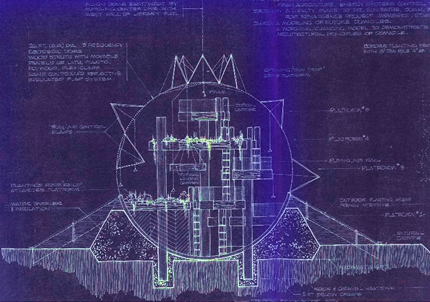 |
| The un built EcoSphere Greenhouse design, 1978, was designed as a prototype for the Renascence Project. At the time, the energy to build it did not reach critical mass - a necessary ingredient for a community project. This design is a community shared and operated greenhouse and recreation environment thereby testing two elements of the Domicile’s program. The food growing capability would be about equal to a four family Domicile. The geothermal system and the opening and closing flaps on the dome are simple examples of the more sophisticated building-earth energy metabolism systems essential for a successful Domicile. |
|
| The EcoSphere Bungalow concept, 1967, 1975, 1979, 2002, 2010, predates the Domicile concept by a few months. I was living in Phoenix at the time and prototyping the design-build process which I am reintroducing now over 40 years later. With the EcoSphere and Domicile designs this was my first thinking, outside of the conventional architectural paradigm, of the social/economic/ecological ramifications of architecture. My design-build explorations provided me a solid understanding of the economics of building. With these projects, I started to explore the economics of owning/using architecture. The development of navCenters, starting in the 80s, extended this approach to the design/build/use process of today. |
|
|
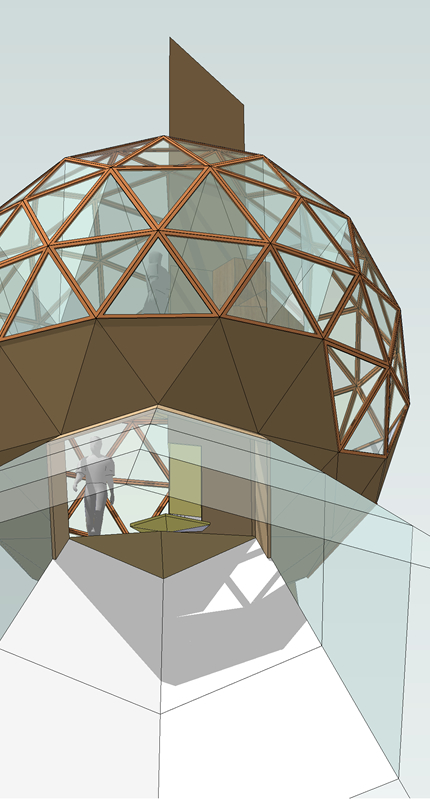 |
| A 2009 study of EcoSphere which provides another view of the design. One aspect which EcoSphere challenges is the concept of floor. Since the late 50s I have been introducing to clients the idea that “floor” has many ramifications other than a flat plane which seems required because we live in a rather strong gravity field. What if we did not? Why are floors always flat? Actually, there are several different kinds of space and consequently different floor functions. There is space for being in, space for organizing tools and utilities and space for seeing. Space which offers refuge and space which reveal prospect. In terms of the floor, there is floor for traveling around, floor for placing things, floor for various activities. Why is the “sitting around together” floor the same as the “walking in the building carrying supplies” floor? |
| In addition to broadening the idea of “floor,” EcoSphere makes clear that a building can be configured in such as way to provide unique vantage points for seeing interior and exterior landscapes. Most buildings are “flat earth” designs and even multi stories are usually one story - and it is an old, often repeated story - stacked on another and repeated several times. Flat earth environments come from flat earth thinking which produces more flat earth buildings no mater how many stories are piled upon one another. |
| Changing the “convenient” arrangement which locates functions in such a way to limit “travel” also is a way to reawake our sense of place, with our ability to see in and out up and down and with light coming - at different times of the day and night - from all 360 degrees, we relate to our setting in new and refreshing ways. |
|
| A 2009 study of Snowflake, 1975, 1979, 1980, 2005, 2007, reveals other possible configurations of geodesic structures. Snowflake is based on a hexipent dome configuration of hexagons and pentagons which brings a base of five hexagons on a level line at the midpoint sides of each dome. This allows for hexagonal rooms to be clustered off of the dome. A dome large enough for a two level interior will provide hex-rooms large enough for most secondary functions. The combining of the two different space-types in various ways produces an amazing number of spaces capable of meeting numerous functional requirements. About 20 prefabricated structural panels can accommodate about 90 percent of the construction of a variety of living, learning and working environments. Snowflake is an ideal structure for temporary and movable buildings as the components easily breakdown in hex and pent modules. |
|
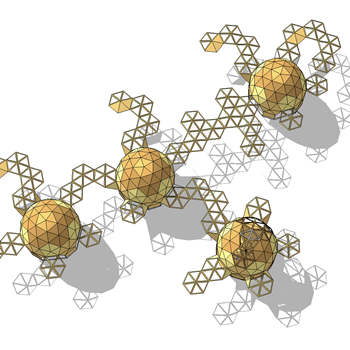 |
| A Domicile can be executed at a variety of scales and in different configurations. It can can be an experiential design bridge between the making of a multi-family habitat, an affinity-based community, a village, and ultimately, a small town scale development. Each of these scale changes will involve a transformation in the social architecture which provides the necessary unity-freedom armature. Also, the energy-ecology equation will involve a punctuated evolution with each of these scale changes. Domicile provides an affordable means to deal with a number of negative conditions chronic in our time while also serving as a lab for the design of future Earth and space habitats. It also may be a useful prototype experience for the construction of Arks in case this becomes an unfortunate requirement in our Human future. |
| Domiciles explore the design Strategy of augmenting-attenuating the bleed through between human and external systems without creating the negative consequences of damaging impacts on the environment or isolation and alienation on the part of humans. Be this in the circumstance of building on an ecologically sensitive site, or conversely on an extreme site where humans cannot now live, or in space, the proper technological development of this design strategy can add significantly to human-nature alternatives. |
| The continuum from a single dwelling to a village, city, mega-structures, to Earth as a habitat is one system, iterative and recursive, repeating the same design strategy patterns over and over. Architecture does not think of itself this way today. The consequences can be seen all around us in squalor to collapsing economies and mass extinction. A city is but a room in our planetary dwelling. A building, a small niche in that room. In our present way of doing things, nature gets to keep what is left over. |
| What this means for the Design Development process of Domicile is that all of a planetary economy-ecology and all of the aspects of human life, husbandry and social economy are to be embedded into a small example of one. Domicile is a solution for a set of problems on one level of recursion and a seed for many other projects of greater scale. Domicile is one way to practice living in an artful and sensible way. |
|
|
posted:
April 15, 2010 • updated Novenber 3, 2010 - 9:56 PM @ Elsewhere |
|
|
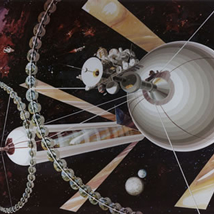 |
|
Early Domicile Design 1968 |
Domicile One 1977 |
L-5 Interview 1977 |
|
|
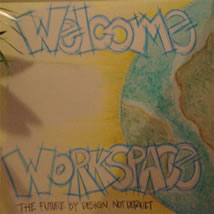 |
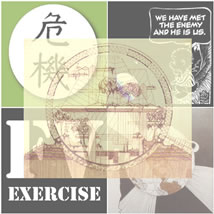 |
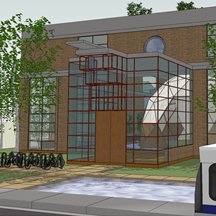 |
Relevant Links |
A Future by Design or... |
FV - Build Your Community
|
|
|
|
